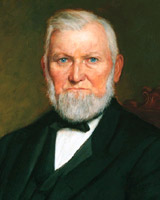|
Wilford Woodruff was born in 1807 at Farmington, Hartford County, Connecticut. The first twenty-five years of his life were spent in attending school, farming, and milling. A quest for religion led to his conversion by Mormon missionaries at Richland, Oswego County, New York, in 1833. During the next decade Woodruff performed extensive proselyting work for the church in the Southern States, New England, and Great Britain. He was among those who introduced Mormonism in England, baptizing some 1,800 people while there. He was appointed to the Quorum of Twelve in 1839, and became church president in 1889, at the age of eighty-three. During his presidency he directed the completion of the Salt Lake Temple and presided at its dedication in 1893.
Woodruff was a member of the Mormon pioneer company that arrived in the Salt Lake Valley in July 1847. In addition to his ecclesiastical responsibilities, he worked hard to support his family on his farm in Salt Lake City which consisted of a garden, orchard, and herds of cattle and sheep. Products from his soil repeatedly won awards at the territorial fair. Besides farming, he enjoyed hunting and fishing, and helped popularize fly-fishing in Utah. He served in a variety of community capacities including the Utah Territorial Legislature, the board of directors of Zion's Co-operative Mercantile Institution (ZCMI), and president of the Deseret Agricultural and Manufacturing Society of Utah, the Utah Territorial Horticultural Society, and the Universal Scientific Society.
Living in the era when plural marriage was an authorized institution of the Mormon Church, Woodruff's family consisted of five wives and thirty-three children. One marriage ended in divorce, and one wife and fourteen of his children preceded him in death.
Wilford Woodruff became Church President at a crucial time in its history. Federal legislation against the practice of plural marriage had resulted in the confiscation of some church property and the imprisonment of many of its leaders, and threatened to impair the functioning of the church. Finding it necessary in 1890 to act "for the temporal salvation of the church," Woodruff issued his now-famous Manifesto which led to the discontinuance of officially sanctioned plural marriages among the Latter-day Saints. A financial crisis incurred by the polygamy crusade, the completion of the Salt Lake Temple, the demands of Church education, increased welfare expenditures and costs of funding local industries due to the 1893 depression, confronted the aging president throughout the remainder of his life.
An avid record keeper, Woodruff served more than thirty years as an assistant church historian, and played a key role in writing the official history of the church. His diary, covering the years 1834 to 1898, is one of the significant records of nineteenth- century Mormonism. "I have never spent any of my time more profitably for the benefit of mankind than in my Journal writing," he wrote. Wilford Woodruff dies in San Francisco on 2 September 1898.
See: Scott G. Kenney, ed., Wilford Woodruff's Journal 1833-1898 (1983); Matthias F. Cowley, Wilford Woodruff (1964). Dean C. Jessee, "Wilford Woodruff," in Leonard J. Arrington, ed., The Presidents of the Church (1986); Thomas G. Alexander, Things In Heaven And Earth: The Life and Times of Wilford Woodruff, a Mormon Prophet (1991).
|


